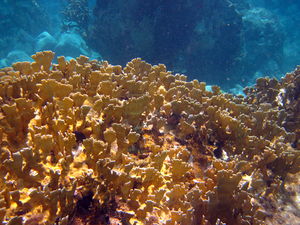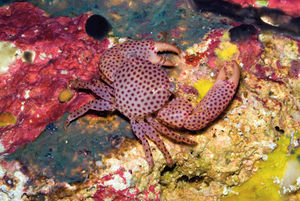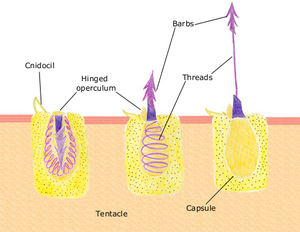DefenseMechanisms
Defense Mechanisms
The Importance of Defense Mechanisms[1]
Corals are sessile, colonial organisms, forever fixed in a certain position by attaching as young polyps to a substrate such as a rock or existing coral. This makes the ocean a very dangerous place for these immobile animals. However, in an effort to combat their immobility, many corals have developed different types of defense mechanisms to protect themselves from the ocean's looming dangers--leading to the production of some of the most lethal toxins found in nature.[2] In this sense, chemical defense is vital to the life of the coral, whose life depends upon its ability to protect itself from predators and invasive species. In fact, some 73% of all coral is toxic to fish, and most of the other species of coral maintain some physical type of defense mechanism to protect against fish predation. [3]
Chemical Defense Mechanisms [4]
Toxins
Many corals posess toxic defense mechanisms for protection. Toxicity levels of different corals was naturally selected for, which has resulted in a direct relationship between how toxic a particular type of coral is and how much nutrition it provides to those who prey upon it. For instance, fish began preying more often upon those corals that had more nutritional benefits, so those corals had to increase their levels of toxicity in order to protect themselves and survive. Corals that had lower nutritional values were less susceptible to predation, so they did not adapt and increase their toxicity levels the way other types had to.
Fire Coral

Despite their toxic defense mechanisms, most corals are relatively harmless to humans, with one exception: fire coral. The particular type of proteinaceous toxin in fire coral affects humans, but only mildly — most reactions just involve stinging pain and inflammatory effects, and the more severe, but rare, side effect is nausea or vomiting [6]. The most common toxins are neurotoxins, and there are three main types. Saxitoxins block sodium channels in the body of species it comes in contact with, causing paralysis and respiratory failure. [7] Palytoxins act on the antiporters that control cell membrane activity, thus disrupting the proper functioning of kidneys and red blood cells and leading to kidney, respiratory and heart failure. The third common type of toxin, the lophototoxin, causes muscle contractions and potential paralysis or respiratory failure by blocking the synapses where nerves connect with muscles.[8]
Symbiotic Relationships
Symbiotic relationships, or close relationships between two species that benefits one or both organisms involved, also greatly benefit corals that are not able to produce toxins on their own. The Coral Probiotic hypothesis, for example, posits that a dynamic relationship exists between coral and the large array of bacteria on their surface, so that when environmental conditions change in the oceans, coral can change which microbial partners they are currently maintaining a relationship with in order to more quickly adapt to those changing conditions. [9]
Trapeziid Crab-Stony Coral Symbiosis

Symbiotic relationships are also maintained between some types of coral and small organisms. The trapeziid crab-stony coral relationship [11] is an example of a symbiotic relationship wherein a small organism (trapeziid crab) lives on the coral reef and benefits the stony coral by removing any excess sediment that falls on the reef. Sedimentation on reefs has been steadily increasing worldwide, but it is detrimental in that it inhibits growth of the coral and accelerates tissue bleaching. In return, the coral offers a few polyps to the crabs as a source of nutritional value for their efforts in cleaning up the reef, in addition to shelter from predation. A healthy coral should have no problem recovering from the trade off of a few polyps. [12] Therefore, the delicate symbiosis existing between the two species must be maintained to support the existence of both species.
In a field experiment conducted at UC-Santa Barbara, Stewart et. al transplanted sections of stony coral with trapeziid crabs, leaving control transects of the reef free of the tiny crabs. Sedimentation was not enhanced en part of the researchers. Results showed that all corals outplanted with crabs survived, while 45-80% of those outplanted without crabs died (bleached) within a month. Those sections of the coral bleached were without crabs. These results suggest that trapeziid crabs play a crucial role in maintaining the health of the reef, not only for the coral itself, but also the other organisms within the reef [13]
Physical Defense Mechanisms
Cnidocyte
A cnidocyte is an explosive cell containing one giant secretory organelle or cnida (plural cnidae) that defines the phylum Cnidaria (corals, sea anemones, hydrae, jellyfish, etc.). Cnidae are used for prey capture and defense from predators. Despite being morphologically simple, lacking a skeleton and usually being sessile, cnidarians prey on fish and crustaceans. A cnidocyte fires a structure that contains the toxin, from a characteristic sub-cellular organelle called a nematocyst. This is responsible for the stings delivered by jellyfish.
Nematocysts [14]

Nematocysts are very efficient weapons. An undischarged nematocyst contains a nematocyte. These small, sub-cellular organelles discharge by firing a barb into a potential victim, leaving a hollow fillament through which poisons are injected to immobilize prey. A single nematocyst has been shown to suffice in paralyzing a small arthropod Cite error: Invalid <ref> tag; refs with no name must have content.
Aggregating sea anemones may have the lowest sting intensity to humans, perhaps due to the inability of the nematocysts to penetrate the skin, providing only a feeling of that similar to touching sticky candies to human fingers. Besides feeding and defense, sea anemone and coral colonies use nematocytes to sting one another in order to defend or win space.
Notes
- ↑ Van Der Weijden, Sander. "Chemical Defense Mechanisms." Chemical Defense Mechanisms. Coral Publications, n.d. Web. 27 Feb. 2013 [1]
- ↑ "NOAA's Coral Reef Information System (CoRIS) - About Coral Reefs." Coral Ecosystem Publications RSS. National Oceanic and Atmospheric Administration, n.d. Web. 27 Feb. 2013.
- ↑ Chemical Defense Mechanisms on the Great Barrier Reef, Australia – Gerald J. Bakus. Science. New Series, Vol. 211, No. 4481 (Jan. 30, 1981). pp. 497-499
- ↑ Chemical Defense Mechanisms on the Great Barrier Reef, Australia – Gerald J. Bakus. Science. New Series, Vol. 211, No. 4481 (Jan. 30, 1981). pp. 497-499
- ↑ Personal photograph by author. 2013. By Brain Naess
- ↑ Moats, William E. "Fire Coral Envenomation." Wilderness and Environmental Medicine 3.3 (1992): 284-87. Print.
- ↑ Ferrer, Ryan P., and Richard K. Zimmer. "Neuroecology, Chemical Defense, and the Keystone Species Concept." The Biological Bulletin 213.3 (2007): 208-25. Print.
- ↑ Marcus, Erin N. "Marine Toxins." Marine Toxins. Ed. James F. Wiley, II. UpToDate, Inc., 17 Dec. 2012. Web. 27 Feb. 2013.
- ↑ REFERENCE
- ↑ Trapeziid Crab. N.d. Photograph. Fishchannel.com. Web.
- ↑ *Stewart, Hannah L., Sally J. Holbrook, Russell J. Schmitt, and Andrew J. Brooks. "Symbiotic Crabs Maintain Coral Health by Clearing Sediments." Coral Reefs 25.4 (2006): 609-15. Print.[2]
- ↑ "Coral Crabs." Coral Crabs. N.p., n.d. Web. 23 Apr. 2013.
- ↑ Stewart, Hannah L., Sally J. Holbrook, Russell J. Schmitt, and Andrew J. Brooks. "Symbiotic Crabs Maintain Coral Health by Clearing Sediments." Coral Reefs 25.4 (2006): 609-15. Print.
- ↑ Kass-Simon, G., and A.A. Scappaticci, Jr. "The Behavioral and Developmental Physiology of Nematocysts." Canadian Journal of Zoology 80.10 (2002): 1772-794. Print.
- ↑ Nematocyst Discharge. N.d. Photograph. National Oceanic and Atmospheric Administration. Web.
comments
good job!
we like the specificity of your topic well organized citations could be greatly improved - this is the formula [1] pictures would be good for visualizing defense also maybe a section on threats or what corals would be defending themselves from?